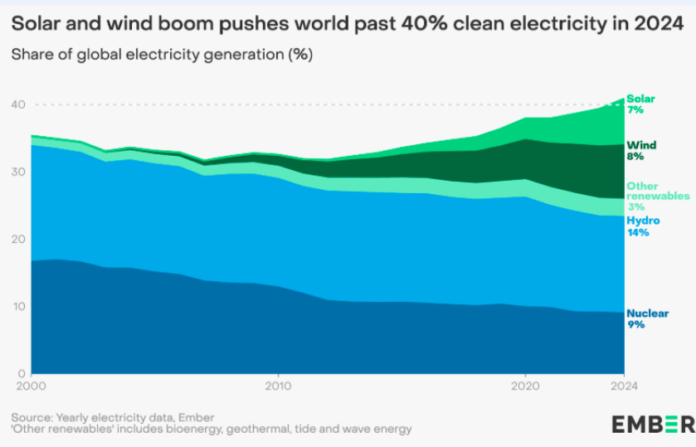Low-carbon sources, including renewables and nuclear, provided 40.9 percent of global electricity in 2024, surpassing the 40 percent mark for the first time since the 1940s.
Renewables added a record 858 TWh in 2024, with solar leading for the third consecutive year by contributing 474 TWh and growing 29 percent.
Solar generation doubled in three years to exceed 2,000 TWh in 2024, reaching a 6.9 percent global share.
Wind provided 8.1 percent of global electricity, while hydro remained the largest renewable source at 14 percent.
Ember’s Global Electricity Review 2025 covers 88 countries representing 93 percent of global electricity demand.
Despite clean energy growth, fossil generation rose by 1.4 percent in 2024 due to heatwaves driving electricity demand, leading to a 1.6 percent rise in global power sector emissions.
Without temperature-related demand, fossil generation would have risen only 0.2 percent, as clean power met 96 percent of non-weather-related demand growth.
Emerging technologies such as AI, electric vehicles, data centres, and heat pumps contributed to 0.7 percent of global electricity demand growth in 2024.
Clean power is projected to grow faster than demand, enabling a decline in fossil fuel generation from 2025 onwards.
Clean electricity growth can meet a 4.1 percent annual increase in demand through 2030, exceeding projected demand growth.
China and India are leading the clean power shift; China’s clean generation met 81 percent of demand growth, and India’s solar capacity doubled in 2024.
Over half of global solar growth in 2024 came from China, which added 250 TWh to reach 8.3 percent of its electricity from solar.
21 countries now generate over 15 percent of their electricity from solar, up from just 3 five years ago.
Solar capacity globally doubled from 1 TW in 2022 to 2 TW in 2024, with 2024 marking the highest-ever capacity addition.
Fossil fuel growth is decoupling from electricity demand in major economies; India’s clean energy met 33 percent of demand growth over the past six years, expected to rise to 75 percent by 2030.
The report predicts a structural global decline in fossil generation, with a modest decrease in the short term and a more substantial decline by 2030.
Experts emphasized the need to unlock financing, promote system flexibility, and ensure affordable energy prices to sustain clean energy momentum.
Asia, especially China and India, is now central to shaping the future of the global power system.
GreentechLead.com News Desk

